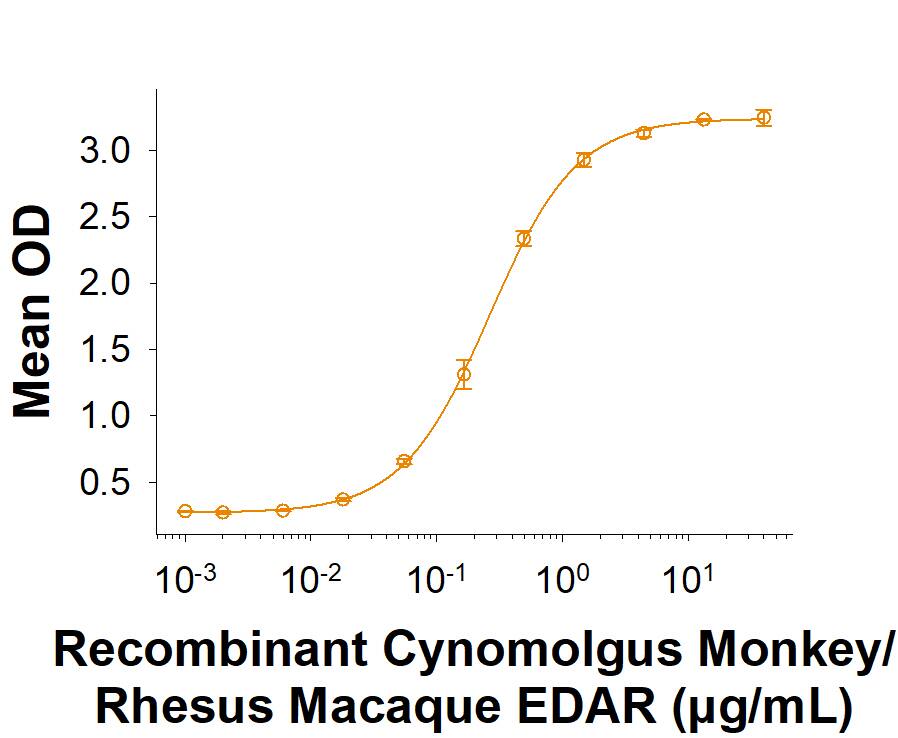Recombinant Cynomolgus/Rhesus EDAR His-tag Protein, CF
R&D Systems, part of Bio-Techne | Catalog # 11350-ER

Key Product Details
Product Specifications
Source
Glu27-Ala187, with a C-terminal 6-His tag
Purity
Endotoxin Level
N-terminal Sequence Analysis
Predicted Molecular Mass
SDS-PAGE
Activity
When Recombinant Human EDA-A1/Ectodysplasin A1 Protein (Catalog # 3944-ED) is immobilized at 2.00 μg/mL (100 μL/well), Recombinant Cynomolgus Monkey/Rhesus Macaque EDAR His-tag (Catalog # 11350-ER) binds with an ED50 of 0.200-3.00 μg/mL.
Scientific Data Images for Recombinant Cynomolgus/Rhesus EDAR His-tag Protein, CF
Recombinant Cynomolgus Monkey/Rhesus Macaque EDAR His-tag Protein Binding Activity.
Measured by its binding ability in a functional ELISA. When Recombinant Human EDA-A1/Ectodysplasin A1 Protein (3944-ED) is immobilized at 2.00 μg/mL (100 μL/well), Recombinant Cynomolgus Monkey/Rhesus Macaque EDAR His-tag Protein (Catalog # 11350-ER) binds with an ED50 of 0.200-3.00 μg/mL.Recombinant Cynomolgus Monkey/Rhesus Macaque EDAR His-tag Protein SDS-PAGE.
2 μg/lane of Recombinant Cynomolgus Monkey/Rhesus Macaque EDAR His-tag Protein (Catalog # 11350-ER) was resolved with SDS-PAGE under reducing (R) and non-reducing (NR) conditions and visualized by Coomassie® Blue staining, showing bands at 28-41 kDa.Formulation, Preparation and Storage
11350-ER
| Formulation | Lyophilized from a 0.2 μm filtered solution in PBS with Trehalose. |
| Reconstitution | Reconstitute at 500 μg/mL in PBS. |
| Shipping | The product is shipped at ambient temperature. Upon receipt, store it immediately at the temperature recommended below. |
| Stability & Storage | Use a manual defrost freezer and avoid repeated freeze-thaw cycles.
|
Background: EDAR
EDAR is a type I transmembrane protein which is a member of the TNF Receptor Superfamily (TNFRSF). The extracellular domain contains 14 cysteine residues, six of which approximate the TNFRSF cysteine-rich region; the cytoplasmic domain contains a region with homology to the death domains found in other TNFRSF members. Based on its high homology with human EDAR, cynomologus EDAR is predicted to be a 488 amino acid (aa) protein with a 26 aa signal, a 163 aa extracellular domain, a 22 aa transmembrane domain, and a 277 aa cytoplasmic domain. The cynomolgus and human EDAR homologs share 99% identity. Within the TNFRSF, EDAR shares the highest homologies with XEDAR and TNFRSF19/TROY. EDA-A1 is the EDAR ligand. EDA and EDAR have been associated with hypohidrotic ectodermal dysplasia (HED). HED is characterized by abnormalities in hair, teeth and eccrine sweat gland morphogenesis. HED was initially found to associate with two gene loci, tabby and downless. Tabby was later identified as the gene for EDA and downless as the autosomal EDAR gene. EDA has two splice variants, EDA-A1 and EDA-A2, which differ by only two amino acids. Despite this minor difference, the EDA isoforms display strong receptor specificity. EDA-A1 only binds EDAR, whereas EDA-A2 binds to XEDAR, an X-linked TNFRSF member with high homology to EDAR. Mutations in EDA, EDAR and XEDAR have been associated with HED.
References
- Headon, D.J. and P.A. Overbeek (1999) Nat.Genet. 22:370.
- Kumar, A. et al. (2000) J. Biol. Chem. 276:2668.
- Monreal, A.W. et al. (1999) Nat. Genet. 22:366.
- Schneider, P. et al. (2001) J. Biol. Chem. 276:18819.
- Srivastava, A.K. et al. (1997) Proc. Natl. Acad. Sci. USA 94:13069.
- Yan, M. et al. (2000) Science 290:523.
Long Name
Alternate Names
Gene Symbol
UniProt
Additional EDAR Products
Product Documents for Recombinant Cynomolgus/Rhesus EDAR His-tag Protein, CF
Product Specific Notices for Recombinant Cynomolgus/Rhesus EDAR His-tag Protein, CF
For research use only

